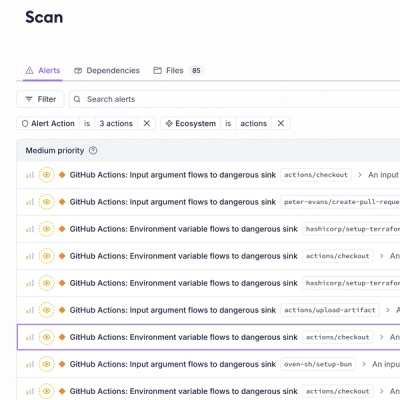
Product
Introducing Socket Firewall Enterprise: Flexible, Configurable Protection for Modern Package Ecosystems
Socket Firewall Enterprise is now available with flexible deployment, configurable policies, and expanded language support.
A middleware layer between a service and a client. The service could be an in-process library, a file, an external web service, anything. Any time the results from a resource call can be cached, you can use ASC as a proxy to that resource.
ASC is a tiered caching middleware that sits between your application and cacheable services. It allows you to define multiple caching layers that ASC will automatically manage and update as needed. The name "ASC" stands for Asynchronous Self-Updating Cache.
npm install asc
import ASC from 'asc';
// Create a cache instance for string keys and number values
const cache = new ASC<string, number>({
memory: {
ttl: 60000, // 60 seconds
disabled: false
},
get: async (key: string) => {
// Fetch data from your source (database, API, etc.)
const value = await someExpensiveOperation(key);
return value;
}
});
// Using the cache
async function example() {
try {
const value = await cache.get('myKey');
console.log('Retrieved value:', value);
} catch (error) {
console.error('Error fetching data:', error);
}
}
const ASC = require('asc');
// Create a cache instance
const cache = new ASC({
memory: {
ttl: 60000, // 60 seconds
disabled: false
},
get: async (key) => {
// Fetch data from your source (database, API, etc.)
const value = await someExpensiveOperation(key);
return value;
}
});
// Using the cache
async function example() {
try {
const value = await cache.get('myKey');
console.log('Retrieved value:', value);
} catch (error) {
console.error('Error fetching data:', error);
}
}
import ASC from 'asc';
import Redis from 'ioredis';
import { Database } from './your-database';
interface UserData {
id: string;
name: string;
email: string;
}
const redis = new Redis();
const db = new Database();
const userCache = new ASC<string, UserData>({
memory: {
ttl: 30000, // 30 seconds
disabled: false
},
layers: [
// Redis Layer
{
get: async (key) => {
const data = await redis.get(key);
if (data) {
return JSON.parse(data);
}
return undefined;
},
set: async (key, data) => {
await redis.set(key, JSON.stringify(data), 'EX', 300); // 5 minutes
},
clear: async (key) => {
await redis.del(key);
}
},
// Database Layer
{
get: async (key) => {
return await db.users.findOne({ id: key });
}
}
]
});
// Usage
async function getUser(userId: string): Promise<UserData> {
return await userCache.get(userId);
}
const ASC = require('asc');
const Redis = require('ioredis');
const { Database } = require('./your-database');
const redis = new Redis();
const db = new Database();
const userCache = new ASC({
memory: {
ttl: 30000, // 30 seconds
disabled: false
},
layers: [
// Redis Layer
{
get: async (key) => {
const data = await redis.get(key);
if (data) {
return JSON.parse(data);
}
return undefined;
},
set: async (key, data) => {
await redis.set(key, JSON.stringify(data), 'EX', 300); // 5 minutes
},
clear: async (key) => {
await redis.del(key);
}
},
// Database Layer
{
get: async (key) => {
return await db.users.findOne({ id: key });
}
}
]
});
// Usage
async function getUser(userId) {
return await userCache.get(userId);
}
Layers are prioritized in the following order:
When get() is called, ASC:
set() method of each layer (if provided) to store the dataThe built-in memory cache uses your process's memory. For optimal performance:
ASC is ideal when:
ASC may not be suitable when:
interface MemoryParams {
disabled?: boolean; // Disable in-memory cache
ttl?: number; // Time-to-live in milliseconds
}
interface CacheLayer<K, V> {
get: (key: K) => Promise<V | undefined>;
set?: (key: K, data: V) => Promise<void>;
clear?: (key: K) => Promise<void>;
}
interface ConstructorParams<K, V> {
memory?: MemoryParams;
layers?: Array<CacheLayer<K, V>>;
get?: (key: K) => Promise<V | undefined>;
}
class ASC<K, V> {
constructor(params: ConstructorParams<K, V>);
get(key: K): Promise<V>;
set(key: K, data: V): Promise<void>;
clear(key: K): Promise<void>;
}
feature/your-feature-namenpm testMIT License - See LICENSE file for details.
FAQs
A middleware layer between a service and a client. The service could be an in-process library, a file, an external web service, anything. Any time the results from a resource call can be cached, you can use ASC as a proxy to that resource.
The npm package asc receives a total of 248 weekly downloads. As such, asc popularity was classified as not popular.
We found that asc demonstrated a healthy version release cadence and project activity because the last version was released less than a year ago. It has 0 open source maintainers collaborating on the project.
Did you know?

Socket for GitHub automatically highlights issues in each pull request and monitors the health of all your open source dependencies. Discover the contents of your packages and block harmful activity before you install or update your dependencies.

Product
Socket Firewall Enterprise is now available with flexible deployment, configurable policies, and expanded language support.

Security News
Open source dashboard CNAPulse tracks CVE Numbering Authorities’ publishing activity, highlighting trends and transparency across the CVE ecosystem.

Product
Detect malware, unsafe data flows, and license issues in GitHub Actions with Socket’s new workflow scanning support.